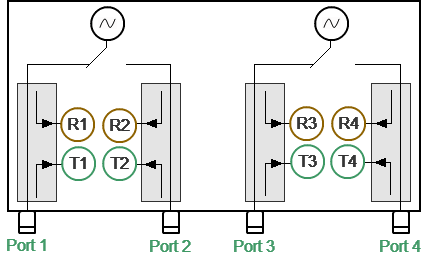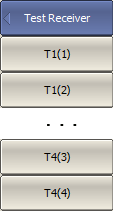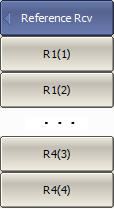Absolute measurements are measurements of the absolute power of a signal at a receiver input. Unlike relative measurements of S-parameters, which represent a relation between the signals at inputs of two receivers, absolute measurements determine the signal power at the input of one receiver. A four-port Analyzer has eight independent receivers: four test signal receivers T1, T2, T3, T4 and four reference signal receivers R1, R2, R3, R4 (See figure below).

There are 32 types of absolute measurements depending on the combination of the receiver and source port numbers (See table below).
Symbols |
Definition |
|---|---|
T1(n) |
Test signal receiver of Port 1 (Source Port n) |
T2(n) |
Test signal receiver of Port 2 (Source Port n) |
T3(n) |
Test signal receiver of Port 3 (Source Port n) |
T4(n) |
Test signal receiver of Port 4 (Source Port n) |
R1(n) |
Reference signal receiver of Port 1 (Source Port n) |
R2(n) |
Reference signal receiver of Port 2 (Source Port n) |
R3(n) |
Reference signal receiver of Port 3 (Source Port n) |
R4(n) |
Reference signal receiver of Port 4 (Source Port n) |
A measured absolute parameter is set for each trace. The trace to which the function is applied must be preselected as active (See Selection of Active Trace/Channel).
|
To select the test signal receiver measurement, click softkeys: Measurement > Test Receiver Then select the required parameter by the corresponding softkey. |
|
To select the reference signal receiver measurement, click softkeys: Measurement > Reference Receiver Then select the required parameter by the corresponding softkey. |
|
|
note |
In absolute measurement mode, dBm measurement units are used for logarithmic magnitude format, and W measurement units are used in linear magnitude format. Other formats are not applicable to absolute measurements. |

